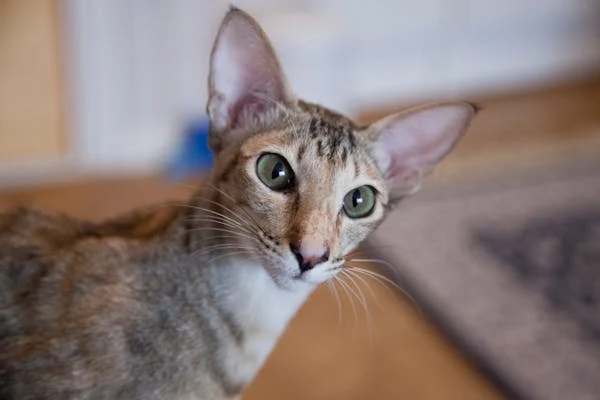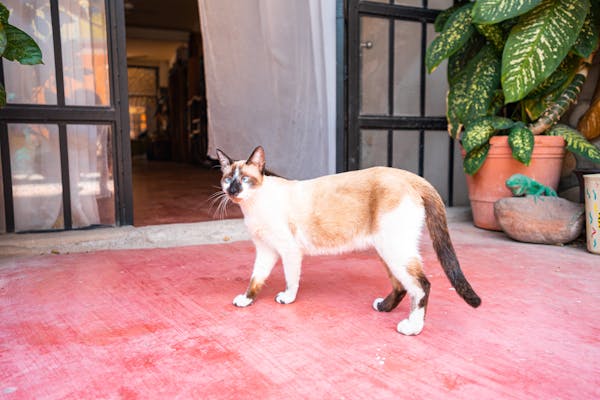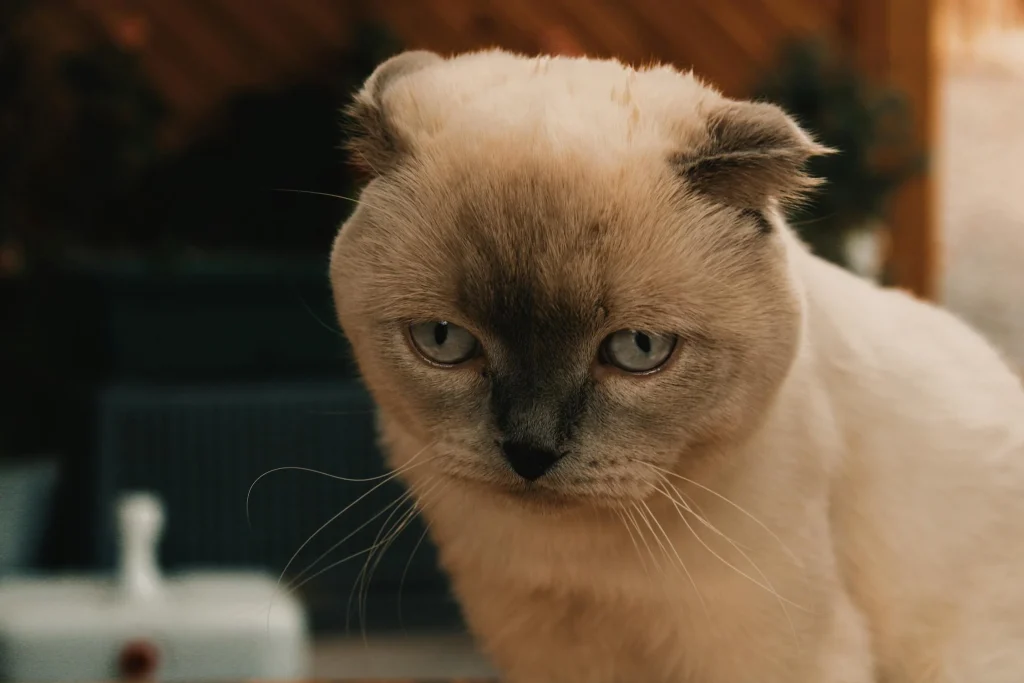I. Introduction
The feline kingdom is a realm of remarkable diversity, where each breed boasts its own unique charm and allure. From the regal Persian to the spirited Siamese, these captivating creatures showcase an array of distinctive physical traits and personalities that never cease to enchant their human companions. Among these singular characteristics, some cat breeds are renowned for their striking and oversized ears, which not only add to their visual appeal but also serve vital functions. As cat owners who have fallen under the spell of these large-eared felines, we can attest to the enchanting presence they bring into our lives.
Elizabeth, the proud owner of an Oriental Shorthair named Simba, shares her experience: “Simba’s ears seem almost comically large for his slender frame, but they give him such a distinctive and endearing appearance. Beyond their visual charm, these sizable ears are a hallmark of his breed and play a crucial role in his exceptional hearing abilities.”
The unique traits of cats, such as their oversized ears, can be attributed to the meticulous selective breeding practices that have shaped these felines over generations. Breeders have carefully chosen and perpetuated specific characteristics, whether for functional purposes or to achieve a desired aesthetic. In the case of cats with big ears, their ancestors may have been selectively bred for their heightened hearing abilities, which could have been advantageous for hunting or surviving in their natural habitats.
II. Cat Breeds with Unique Ear Characteristics
While cats with big ears may seem like a novelty to some, there are several well-established breeds that are celebrated for this very trait. Let’s delve into some of the most popular ones, with insights from cat owners who have firsthand experiences with these captivating felines.
Oriental Shorthair
As mentioned earlier, the Oriental Shorthair is renowned for its large, wide-set ears. Elizabeth, Simba’s owner, shares her perspective: “Simba’s distinctive ears, combined with his sleek and slender body, give him an almost bat-like appearance that is both striking and endearing. But these large ears aren’t just for show – they also contribute to his exceptional hearing abilities, allowing him to pick up on the faintest of sounds, whether it’s the scurrying of a mouse in the walls or the gentle rustling of a toy across the room.”

Siamese
One of the most iconic and recognizable cat breeds, the Siamese is known for its elegant and striking appearance, including its large, triangular-shaped ears. Jessica, the proud owner of a Siamese named Bella, shares her experience: “Bella’s large ears are not only a defining feature of her breed but also play a crucial role in her ability to communicate effectively. Siamese cats like Bella are known for their vocal nature, and her large ears help her to better perceive and respond to various sounds and tones, whether it’s my voice calling her name or the subtle chirping of a bird outside.”

Sphynx
While the Sphynx is primarily known for its hairless and wrinkly appearance, this breed also boasts impressively large ears in proportion to its body size. Michael, the owner of a Sphynx named Yoda, explains: “Yoda’s oversized ears not only add to his unique and otherworldly look but also serve a vital function – helping him regulate his body temperature. As a hairless breed, Yoda relies heavily on his large ears and other exposed areas to dissipate excess heat, allowing him to stay comfortable even in warmer environments or during periods of activity.”

Devon Rex
The Devon Rex is a quirky and charming breed with a distinctive, curly coat and a mischievous personality. But one of their most striking features is their large, low-set ears that give them an almost elf-like appearance. Emily, the owner of a Devon Rex named Muffin, shares her perspective: “Muffin’s ears seem almost too big for her petite frame, but they only add to her endearing and whimsical charm. Her large, low-set ears are a defining feature of her breed and a constant source of fascination for me – they make her look like a tiny, curious elf exploring the world around her.”

Scottish Fold
While not specifically known for their ear size, the Scottish Fold breed has a unique ear characteristic that sets them apart – their folded ears. This breed’s ears are folded forward and down, giving them a distinctive and endearing “owl-like” appearance. David, the owner of a Scottish Fold named Pumpkin, shares his experience: “Pumpkin’s folded ears are not only a defining feature of her breed but also a constant source of joy for me. They give her such a unique and charming appearance, and I can’t help but melt every time she cocks her head and those adorable ears tilt forward, making her look like a wise little owl.”

These are just a few examples of cat breeds that have been selectively bred for their unique ear characteristics, with insights from owners who have fallen under the spell of these captivating felines. Whether for functional purposes or purely for aesthetic reasons, these distinctive ears have become a defining feature of these breeds and a source of fascination for cat lovers worldwide.
15 Cat Breeds with the Biggest Ears!
III. Importance of Ear Size in Cat Breeds
While the large ears of certain cat breeds may initially seem like a purely cosmetic trait, they actually serve important functions and contribute to the overall well-being of these felines. Let’s explore some of the key roles that ear size plays in the lives of cats, with insights from owners who have experienced these benefits firsthand.
- Hearing and Communication
Cats rely heavily on their sense of hearing for a variety of purposes, from hunting and navigating their environment to communicating with other felines and their human companions. Larger ears can help enhance a cat’s hearing abilities, allowing them to pick up on even the faintest of sounds.
Elizabeth, Simba’s owner, shares her experience: “As an Oriental Shorthair, Simba’s heightened sense of hearing is truly remarkable. His large ears allow him to pick up on sounds that I can barely perceive, whether it’s the rustling of a mouse in the walls or the faint jingling of his toy from across the room. This heightened hearing has been particularly advantageous for his hunting prowess, as he can easily track and locate even the most elusive prey with pinpoint accuracy.”
Additionally, ear size and shape play a crucial role in a cat’s ability to communicate effectively. Cats use a variety of ear positions and movements to convey different emotions and states of mind. Jessica, Bella’s owner, explains: “Bella’s large, triangular-shaped ears are so expressive! I can easily tell when she’s alert, content, or even slightly annoyed just by observing the subtle movements and positions of her ears. These larger ears make her nonverbal cues more pronounced, facilitating better communication between us and allowing me to respond to her needs more effectively.”
- Temperature Regulation
In some breeds, such as the Sphynx, large ears serve an important function in regulating body temperature. These hairless cats rely heavily on their ears and other exposed areas of their bodies to dissipate excess heat. Michael, Yoda’s owner, shares his insight: “As a Sphynx, Yoda’s large ears play a crucial role in helping him maintain a comfortable body temperature. The increased surface area of his ears allows for more efficient heat transfer, which is especially important in warmer environments or during periods of activity. I’ve noticed that when Yoda gets overheated, his ears become even more prominent as they work to cool him down.” - Breed Identity and Visual Appeal
While not necessarily a functional aspect, the unique ear characteristics of certain cat breeds have become an integral part of their identity and visual appeal. For many cat owners and enthusiasts, these distinctive ear shapes and sizes are a major draw, adding to the overall charm and allure of these breeds.
Emily, Muffin’s owner, shares her perspective: “Muffin’s large, low-set ears are not only a source of endearment but also a defining feature of her Devon Rex breed. These ears, combined with her curly coat and mischievous personality, create a truly captivating and whimsical feline companion that never fails to bring a smile to my face. Whenever she tilts her head and those oversized ears shift, it’s like she’s casting a spell of pure delight over me.”
David, Pumpkin’s owner, echoes a similar sentiment: “Pumpkin’s folded ears are an integral part of what makes her breed so unique and charming. Whenever she tilts her head and those adorable ears shift forward, it’s like she’s casting a spell over me – one that fills me with pure joy and adoration. Her folded ears give her an endearing, owl-like appearance that never fails to melt my heart.”
IV. Caring for Cat with Big Ears
While the large ears of certain cat breeds can be a source of fascination and delight, they also require some special considerations when it comes to grooming and overall care. Here are some tips for ensuring the health and well-being of cats with big ears, with insights from owners who have navigated these challenges.
- Grooming and Cleaning
Cats with large ears may be more prone to accumulating dirt, wax buildup, and debris within their ear canals. Regular cleaning and grooming are essential to prevent potential ear infections or other ear-related issues.
Elizabeth, Simba’s owner, shares her experience: “As an Oriental Shorthair, Simba’s large ears can easily trap dirt and debris, which can lead to discomfort and potential infections if left unchecked. I make it a point to gently clean his ears with a vet-approved solution and cotton balls every week or as needed, being careful not to insert anything too deeply into his ear canal. It’s a delicate process, but one that’s necessary to keep those big ears healthy and free of buildup.”
Jessica, Bella’s owner, adds: “Siamese cats like Bella are known for their vocal nature, which means their large ears are constantly exposed to the sounds they make. To prevent wax buildup or irritation, I regularly clean Bella’s ears using a gentle, vet-recommended ear cleaning solution and soft cotton pads. It’s a small task, but it goes a long way in keeping her ears clean and comfortable.”
- Ear Health Monitoring
Due to their larger ear canals, cats with big ears may be more susceptible to ear infections or other ear-related issues. It’s important to regularly inspect your cat’s ears for any signs of redness, swelling, discharge, or odor, which could indicate an underlying health problem. If you notice any concerning symptoms, promptly consult with your veterinarian for proper diagnosis and treatment. Raed can cats eat cherries
Michael, Yoda’s owner, shares his experience: “As a Sphynx with oversized ears, Yoda is prone to ear issues if I’m not vigilant. I make it a habit to gently examine his ears every week, looking for any signs of irritation, discharge, or an unpleasant odor. If I notice anything out of the ordinary, I don’t hesitate to schedule a visit with our vet, as ear infections can quickly become serious if left untreated.”
David, Pumpkin’s owner, adds: “While Scottish Folds like Pumpkin aren’t necessarily known for their ear size, their unique folded ear shape can sometimes make them more susceptible to ear issues. I regularly check Pumpkin’s ears for any signs of redness, swelling, or discharge, and I’m always sure to keep her ears clean and dry to prevent any potential problems.”
- Protecting Ears During Grooming and Play
Cats with large ears may be more susceptible to accidental injuries or irritation during grooming or playtime. When brushing or combing your cat’s fur, be mindful of their ears and take extra care not to accidentally pull or catch them. Additionally, during interactive play sessions with toys or lasers, be cautious not to direct them too close to your cat’s large ears, as the sudden movements or sounds could startle or potentially cause discomfort.
Emily, Muffin’s owner, shares her experience: “As a Devon Rex with large, low-set ears, Muffin’s ears are particularly vulnerable during grooming sessions. I’m always extra careful when brushing her curly coat, making sure to gently work around her ears and not accidentally pull or snag them. During playtime, I also make sure to keep any toys or laser pointers a safe distance from her ears, as the sudden movements or sounds could startle her.”
Elizabeth, Simba’s owner, adds: “Simba’s large, bat-like ears are quite sensitive, and I’ve had a few instances where he’s been startled or slightly pawed at his ears during particularly rambunctious play sessions. Now, I’m always mindful to keep any toys or lasers away from his ear area to avoid any accidental discomfort or injury.”
By taking these precautions and providing proper care, cat owners can help ensure the health and well-being of their feline companions with big ears. These unique features not only add to the charm and allure of these breeds but also require special attention to maintain their functionality and prevent any potential issues.
V. Conclusion
The world of cats is a captivating one, brimming with an array of breeds that showcase an incredible diversity of physical traits and personalities. Among these distinctive features, the large ears of certain breeds stand out as not only a visually striking characteristic but also a functional adaptation that serves important purposes.
As we’ve explored throughout this article, cats with big ears, such as the Oriental Shorthair, Siamese, Sphynx, Devon Rex, and Scottish Fold, have been selectively bred for their unique ear characteristics. These oversized ears not only contribute to their endearing appearances but also play vital roles in enhancing their hearing abilities, facilitating effective communication, and aiding in temperature regulation.
Through the insights of dedicated cat owners like Elizabeth, Jessica, Michael, Emily, and David, we’ve gained a deeper appreciation for the importance of these large ears and the special considerations they require in terms of grooming, ear health monitoring, and protection during playtime.
As cat lovers, we are constantly in awe of the diversity and uniqueness that each breed brings to the feline world. Cats with big ears are a testament to this incredible variety, reminding us of the fascinating adaptations that have shaped these beloved companions over generations of selective breeding.
Whether you’re an owner of a large-eared feline or simply an admirer of these captivating creatures, there is no denying the charm and allure that these distinctive ears bring to the world of cats. From Simba’s bat-like ears to Pumpkin’s endearing folded ears, these feline features have the power to capture our hearts and fill us with wonder and delight.
Read Also



